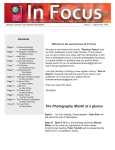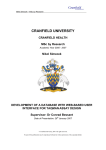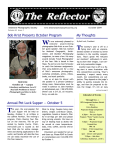Download Enough Already - Oshawa Camera Club
Transcript
Issue 38 - March, 2014 President’s Musings Enough Already Enough winter....enough snow, enough cold!! With daylight savings time here, I suppose there’s some light at the end of the tunnel, but here are my top 10 reasons why winter gets in the way of photography: 10. 9. 8. 7. 6. 5. 4. 3. 2. Your equipment gets too cold to handle. ;-) You keep forgetting to take large zip lock bags with you to keep condensation off your camera and lenses. Your batteries die too quickly. It’s either too dark or too bright, too early or too late. Too much white is boring when you can’t find any black to go with it except, of course, the dirt that’s mixed in with it. You can’t get to the places you normally would because there’s too much snow! Your fingers freeze even with gloves.....they’re fingerless! Winter clothes make you look fat. Too much time spent at the piers taking pictures of the ice-wrapped lighthouses! And my #1 reason why winter gets in the way of photography.... 1. It doesn’t necessarily have anything to do with photography, but I can’t wear sandals! Come on spring....heat, bbq’s, festivals, markets, flowers, birds on sticks!! Leif Petersen Table of Contents President’s Musings.......................................................Page 1 Club News......................................................................Page 3 The Nature Photographers Journal...............................Page 5 Camera Club Members Get GAS by Chas Hamilton.....Page 7 An Image for Inspiration by Bob Bourke.......................Page 8 Competition Corner by Randy Nickerson.....................Page 13 Clinic Winners from Competition 4..............................Page 14 Get to know Tim McGill................................................Page 20 Upcoming Dates Wed. Mar. 26 Sat. Apr. 12 Wed. Apr. 23 Sat. Apr. 26 Peter Van Rhijn guest speaker Wildlife Photography Workshop with Norm Ullock Tim Claydon presents Astral Photography GTCCC Awards Night. Editor: Paula Bund Page 2 For more information, please go to: http://gtccc.ca/educationdays.php Page 3 Please join us PINERIDGE ARTS COUNCIL PRESENTS THE GTCCC Interclub Awards Show Saturday, April 26, 2014. (Must Register Online for Tickets) This is the Awards show & Print Gala from this years Interclub Competition. The Print viewing is divided into 2 sessions - order your tickets accordingly. • Registration is now open. You can register at www.GTCCC.ca • Cost for both events is $15.00 per person. Guests are always welcome. • There are two exhibition times for the Print Gala & Reception. You must choose only one time to attend. • Print Viewing times are: 5:00-6:30 pm or 8:30-10:00 pm • Theatre doors open at 6:30 pm Show begins at 7:15 pm. • Awards presentation at the Regent Theatre on Mt. Pleasant Rd., TO Awards Presentation and Opening Reception Expression E xpression of Interest Deadline • February 28 • Thursday, April 17 beginning at 7 p.m. McLean Community Centre 95 Magill Drive, Ajax • Print Gala & Reception at the Toronto Camera Club both are on Mt. Pleasant Rd., TO • Parking Lot just north of Toronto Club west side of street. Direct Link for Show Tickets are on the OCC News Page. For your complete list of Deadlines, Entry Fees, Exhibition Dates, Rules and Details, and to download Expression of Interest form go to www.pineridgearts.org/jpe.html Got more questions? [email protected] Page 4 The Nature Photographer’s Journal by Norm Ullock Are Your Images Sharp? Check Your Lens Calibration One of the most common complaints I hear from people is that they often don’t get sharp images. When cameras and lenses come off the production line they are calibrated to certain tolerances so that focus will be “within specifications” if it is between X and Y. Therefore, if your camera is within spec but closer to X and your lens is within spec but closer to Y, then you may have a focus issue. There are many reasons why this can happen. Fortunately there are easy ways to check and correct the problem. Soft focus can be the result of your camera, lens or your technique. This month I would like to look at how to check a lens either old or new, to make sure the focus point is correct and in focus to provide you with sharp images. Obviously, if your shooting technique is not correct then calibrating your equipment alone will not solve the problem. However, I believe that we should all check our gear for correct calibration so that if we still are not getting sharp images then we know the problem exists with the technique in the 12 inches immediately behind the camera (your head). But I paid good money for my lens.... It is easy to believe that if we buy a lens and pay good money for it that it will be correctly calibrated. Most good lenses will be bang on and you will get sharp results. But the truth is that there are some very good lenses that may not be perfectly calibrated for your camera. Can I calibrate a specific lens with my camera? Many of the newer D-SLRs come with a feature that allows the owner to fine tune the autofocus of a specific lens. When you perform a lens calibration and make the adjustment to your camera and save the setting, then every time you mount that lens serial number on your camera those fine adjustments will be used. If you mount another lens on your camera then the default setting (no adjustment) will be used. If your camera body does not have the auto focus fine tuning capability then you can take pictures that show the focus problem and take the lens and camera into your camera manufacturers’ service centre and ask them to make the adjustments. How to check whether your lens is focusing properly I found a good article on how to check for front or back focusing on the Internet. Most of the meat in the process is from pages 10-18. and includes a chart you can print out to use for the test. This is the link to read it. www.dphotojournal.com/focus-test-chart.pdf Personally I do two tests. For the first test I photograph three AA batteries that have some small print on them and the second test I photograph a printed sheet. I’ll describe each. First test — Mount your camera on a tripod with a remote cord so that you don’t touch the camera to trip the shutter. Focus on the centre AA battery and take a shot. Bring that shot up on your computer display and check the result. The image below shows what the result will look like if your lens is calibrated properly with the sharpest part of the picture being the middle battery. If the lens is within warranty this will likely be a free service, but it may take 5-10 days plus shipping or pickup and delivery by you. So if you can do it yourself in an hour it is much more convenient. Why would my lens not focus properly? When a lens is out of calibration for focus it is usually because it does something called front or back focusing. This means that although you put the focus square in your viewfinder on a specific point the lens is actually focused best on a point slightly in front of or behind the point you are trying to focus on. Page 5 The Nature Photographer’s Journal, cont’d... The image below demonstrates a problem with front focusing. It shows the forward battery is the sharpest of the three and therefore this lens has a front focus issue. Conversely, if the sharpest battery is the rear one, then the lens has a back focus issue. If you are testing a long focal length, then I suggest doing the test at the longest focal length, which is usually where you use the lens. So for a 70-200mm I would test it at 200mm. The image below demonstrates a lens that is correctly calibrated . Notice the sharpest point is about 0 mm. Conclusion If you are not sure your lens is correctly calibrated, finding out is worth your time. Macro and long focal length lenses, where the depth of field is very shallow, are particularly important to ensure correct calibration because a back or front focus problem will result in out of focus images. In most cases you will find that your lens is correctly calibrated. In this case the out of focus issue is caused by the bipod that is operating the camera, and an improvement in steadying technique or DOF control would ensure better results. Calibrating the lens is a quicker fix than fixing the bipod problem. Norm The image below shows a lens with a front focus problem as the sharpest point seems to be the front 6 mm point. Second test — With the camera still on a tripod, point it 45 degrees down to the floor looking at a chart (from the above referenced article). The full chart looks like this. What to do if you find a problem If find that your setup is providing you a front or back focus issue, then perform the auto fine tuning adjustment for the lens that is mounted on the camera body. Since each camera and brand is different, you need to check your SLR user manual for the process. It’s generally a very simple process. On a Nikon body it is in the menu with the wrench icon (setup) and it is near the end of the items in that menu. It is called “AF Fine Tune.” On a Canon body it is called “AF micro adjustment” and is usually found under “Custom Function Settings”. Page 6 Article by Charles Hamilton Camera Club Members Get GAS I’m talking about Gear Acquisition Syndrome of course. We all get it at sometime, and there is only one known cure. You’re going to have to find out exactly what you need, then go and get it! I’m talking bodies and lenses here, the things that make a big dent in your wallet. The voice in your head then asks if you really need it. Is it the right one? Am I paying too much? Where should I buy it? The importance of retail stores Before we explore those questions I would like to stress the importance of having a trusted adviser, preferably at your favourite camera store. As you walk in, they should know your name, what you like to photograph, what kind of gear you own, your level of expertise, and how you budget. Yes, Uncle Fred the Pro Photographer is probably a good resource for technique, but likely knows only his own gear. As you work on becoming a great all-around photographer, you will need a solid tripod, flash and great lenses to challenge you and expand your experience. Now that you have a bewildering array of complex electronic gear available from so many sources, it’s even more important to discuss your goals with a retail expert. They will make sure everything in your work flow will work together and, if you have purchased everything from them, they should guarantee it. A mistake, after all, could be very expensive! Finding competitive prices When is the best time to buy? So, now you have made a decision. How do you know your favourite store has a competitive price? You should have www.photoprice.ca handy. Most stores will price match, though some will just come close. Hopefully the advice you have received is worth something! Your best time to purchase a new lens or body is when a manufacturer’s rebate is in effect. With margins very slim in our competitive market, you could be purchasing it below the retailer’s cost. (Good for you!) Buying used All I’ve talked about is new gear. What about used? I don’t recommend buying used from Kijiji or eBay unless you are an expert at evaluating equipment, know exactly what you are getting and what the market value is. I again suggest checking with your retail advisor. Many stores do take equipment in trade and will guarantee it for up to 6 months. What are the best things to buy used? Flash units, tripods and lenses are a safe bet. For example, a pro lens like a 24-70 f2.8 may have a current version II available and a used version 1 in mint condition for ½ the price. Is the new one twice as good? You be the judge! Camera bodies I suggest purchasing new, as they are more complex and full warranty is important. Hopefully these are helpful things to think about. I’ll be happy, as always, to answer any questions. Happy hunting! Next article But.........should I buy on-line? What about the cheaper US pricing? Well these are topics for a future article. Charles Hamilton Page 7 Article by Bob Bourke An Image for Inspiration Sometimes an image will just grab me. This was the case with “Through the Looking Glass” by Allan de la Plante. It may be a departure from the genre of images he is best known for but reinforces the quality of his artistic talents as an image maker. As a professional photographer and author, Allan has achieved international acclaim for his books and images of sports, in particular auto racing figures. He, however, has an eclectic eye for good subjects that take him beyond his bread-and-butter topics to other fields of interest. Here we see a captivating image of his wife Angela. It is one of two shots taken during a test. The image was commented on by his friend, a very prominent American portrait photographer that wishes to remain anonymous, who admitted it was one of her favourites. The image is simple in composition but at the same time complex and intriguing in content. To most, the image is puzzling in some way as it poses more questions than answers. Different viewers can imagine different stories as they draw upon their own experiences to try to understand it. It is this uncertainty of the situation that creates the mystique of the image that causes many to revisit it time and time again. The image begs contemplation — a curiosity about the situation. The expression on the subject’s face is inconclusive as it might convey a range of different thoughts or emotions. A more subtle feature is that her chin is supported by a closed hand reminiscent of Rodin’s “The Thinker” that suggests deep thought. Somehow the drama it presents is made more complex as she gazes through a pane of raindrop speckled glass in a view of her face partially framed with light reflections. So what is the story? Only you have the answer. Through the Looking Glass by Allan de la Plante About the photographer Allan de la Plant has been a professional photographer for over 4 decades. He has photographed and authored 14 books. His work has featured many professional and Olympic sports personalities amongst other things. Allan grew up in North Bay, Ontario and now resides in Burnaby British Columbia. Allan credits Bill Schorse as one of his mentors who inspired Allan to direct his artistic bent towards his pursuit of photography. For more information on Allan, his books and accomplishments visit: www.allandelaplante.com/ Page 8 Growth in participation and quality Competition Season is Nearly Over! So here we are at the end of our competition season where we have seen some of the best photos on mass that I have ever seen! At our last meeting, Vern Mossey, who knows a thing or two about taking a photo, spoke glowingly about the OCC’s level of talent. I personally am excited to see how we do at the annual GTCCC competition on March 8. Fun facts I like to share a few fun facts at this time of the year. This year’s are as follows: • 1185 photos were entered this year during the four major competitions. That’s an average of close to 300 per competition and is a definite record since I have been the Competitions Director • There were 414 honourable mentions, again the highest number since I have been doing this job • Currently the top 10 members are all over 450 which is an average of 22.5 pts. per photograph • The current leader has 481 points, the second highest, just under Sharon Januwsheski’s total score of 489 last year • Eight Dancey members will be elevated to Miller, which is the most I have seen promoted since I have been in the club. Congratulations to following Dancey members Speaking of Dancey to Miller members, I would like to congratulate the following on their great competition season • Jan Novada • Theo Tan • Malcolm Parr • Cathy Booth-Smith • Alex Robertson As Competition Director I have the privilege of promoting individuals that show advanced or professional skill but for missing a clinic or a picture entry they did not completely meet the miller graduating requirements. This is the case with David Clow, Brian Dougherty and Robin Piereira. In David’s case he had 15 HM’s while only entering 3 competitions. For Brian, he had 13 HM’s and 398 points missing one entry and in Robin’s case he had 11 HM’s and 392 pts. with missing 2 entries. Congratulations to David, Brian and Robin. Looking forward This year has seen great growth in the club from amount of participation (55-60 %) to the quality of work. The question is, how can the club maintain this direction and even grow it? That is a question I put out to everyone. Please volunteer in some capacity, share ideas, ask questions. Bill Peel would be more than happy to discussion educational thoughts with you. I would love to hear your ideas on the competitions and how to make them better. Next year’s new president, Sharon Janushewski would echo that sentiment and encourage any feedback that you might have. Competition 4 Pictorial: Lady In Red by Norm Ullock As for this year’s president, Leif Peterson, I consider it a great privilege to have been able to work with him and his leadership has carried on from the other great presidents that we have had. I have included my favourite photographs from this year’s competitive season. Page 9 Competition 2 Special Category: Oshawa Law Court by John Ronson Competition 2 Special Category: Rose Blanche Lighthouse by Sharon Janushewski Page 10 Competition 3 Nature: Red Fox in Habitat by Norm Ullock Competition 1 Special Category: Road to Krisuvik Iceland by Bharat Mistry Page 11 Competition 4, Nature: King Bird in Habitat, by Norm Ullock, Miller Score: 10 9 9 for a total of 28. Comment from judges: Good lines, lighting and sharpness Page 12 Competition 4, Nature: Red Tailed Hawk by Ron Warner, Dancey Score: 8 9 8 for a total of 25. Comment from one Judge: Well lit, good detail in whites Page 13 Competition 4, Pictorial: Frozen Waves by David Manuel, Dancey Score: 10 9 8 for a total of 27. Comments from judges: Beautiful tone and colour. Great lower viewpoint to the prize at the end. Wonderful. Page 14 Competition 4, Pictorial: Medial Moraine by Roger Langely, Miller Score: 9 10 9 for a total of 28 Comments from judges: The only thing stopping this from being a 10 is the horizon line is not straight. Bravo on the photo. Hang it proudly on your wall. Page 15 Competition 4, Special: Reagan by Lois Child, Dancey Score: 9 9 7 for a total of 25 Comments from judges: What can I say? Impact, mood, expression as well as technical perfection. All are in this image. and A bit more of the model to the right would score an additional point Competition 4, Special: Why so Serious by Bharat Mistry Score: 7 9 10 for a total of 26 Comments from judges: Central placement and tight cropping are effective in this image. The post processing technique works well with this subject Page 16 Competition 4, Special: Photog Nouveau by Bharat Mistry Score: 9 9 8 for a total of 26 Comments from judges: This image is a great example of a creative person making a photo as opposed to taking one. The impact has been achieved by unique lighting, subject expression, complementary colour selection, and the use of graphic art. Outstanding. Page 17 Aldsworth’s Online Challenge - S-Curves S-Curves by Denise Yaknowiec Page 18 Page 19 Get to know us! Meet Club Members Tim McGill, Featured Photographer of the Month been dark acclimated. Speeds and sensitivities are just mind-boggling! But most people would be very surprised that resolutions for most high end imaging cameras rarely exceeds 1.2 Mp. Through all of this, with my growing family and busy work life, photography took a bit of a back seat and it wasn’t until about 5 years ago, when our kids went off to university and started to get their own lives, that I got my first serious digital SLR camera, a Nikon D700. This was the first full-frame Nikon that I could use all of my older lenses with. Well, from there it really took off. My passion for photography is back and I have been shooting ever since. I have enjoyed photography all of my life. Yes, I started as the Yearbook geek at high school who took pictures of all the sports teams. :) After working part-time at Black’s and Jerry’s Cameras while in university, I went to work for Leica. This involved medical and research imaging in the life sciences. In my “day-job” for the last 29 years, I have been involved in specialized medical and scientific imaging, starting with photography with film and then progressing through digital to its current state. Some of the things that are done with these specialized, high-end scientific imaging cameras is absolutely incredible. Sensitivity so high that you can’t see it with your eyes .... even if you had I started back with motor-sports photography and have been doing this from the beginning. I am a photographer for two motorsports magazines here in Toronto. However, I felt it was a shame that my expensive gear didn’t get used too much in the “off-season” from racing so I started to get involved in workshops and studio work for portraiture. This has become a real passion as well as it really tests your control of light, angles, tones and communications with the subject too. I love all different genres and am always experimenting, trying different things, going to lectures, attending workshops ... trying to learn all the time. The future is full of possibilities. InFocus asked Tim to choose his favourite photo and tell us about it.... “Kinda hard to choose a favourite, as it is like asking me to name my favourite child! I do a number of genres of photography, so with all of these it is really hard to choose. This pic is a real favourite of mine as it was one of the first pictures I took sitting down and focusing on portraiture. It was in the small studio that I rent and it was with constant CFL lighting. I like the style and simplicity of the black and white image. My kids have always got along together (not the regular brother and sister thing) and this picture, I think, brings this out.” To view more of Tim’s work go to: www.oshawacameraclub.ca/members.html “The future is full of possibilities.” Page 20 Oshawa Camera Club email: [email protected] web: www.oshawacameraclub.ca facebook: www.facebook.com/groups/331347436936878/ The Oshawa Camera Club is now in its 75th year of continuous operation. It serves the photographic community of Durham Region and the surrounding area. We meet on the second and fourth Wednesday of each month at 6:40pm from September to May, at The Woodview Club, which is located in Oshawa at 151 Cadillac Avenue North, between King and Adelaide. Visitors are always welcome at our regular meetings. This newsletter would not be possible without the time and effort put in by a very talented team of photographers and writers. A special thanks to Bharat Mistry at q-vision who developed the graphics used throughout this newsletter. Published by Paula Bund on behalf of the Oshawa Camera Club. Email questions and comments to: [email protected] The articles and photographs in this newsletter are copyrighted and are not to be reproduced or modified without the creator’s written permission. For more information or a release, please contact the editor at: [email protected] Page 21








































